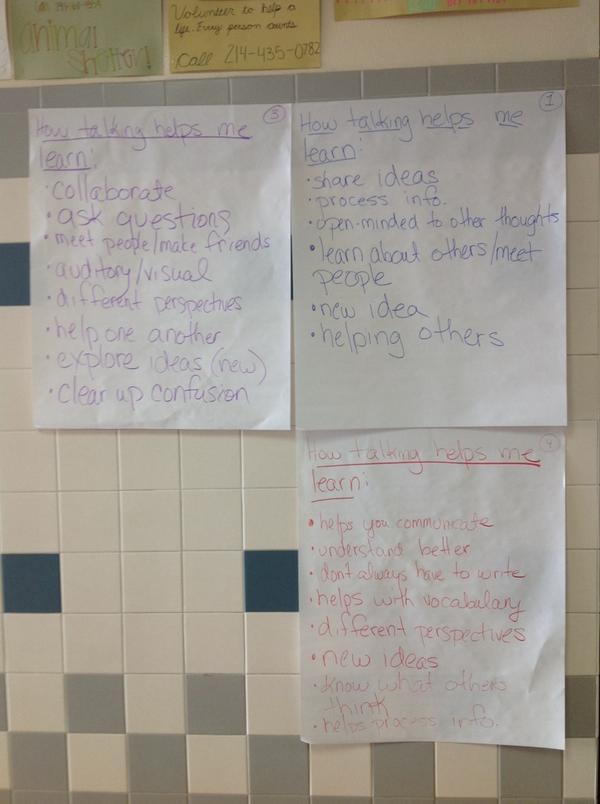Part I: Academic v. Social Conversations
In this lesson, I taught the Think-Pair-Share strategy. This is one that I use often. This strategy shows up in many of the trainings I attend and is also a component of our school AVID program. This is one of my favorite strategies to use because it gives all students a chance to process information. My classroom consists largely of English Language Learners, dyslexic students, and those who failed the state reading test. These kids need time to think and share ideas without the pressure of being wrong.
We used the Think-Pair-Share ideas to create anchor charts, showing how students can learn from talking:
One part of this lesson did not work: the t-chart. My students had a difficult time coming up with ways to characterize what academic conversations are and are not. When I saw this backfire, I started presenting examples for the kids to categorize.
The biggest benefit: As soon as this lesson was complete, I started using the terms social and academic conversation while the kids were working. As soon as I asked social groups which type of conversation they were using, they were able to immediately get back on track.
Part II: Learning Target
Once it was clear that we were now moving away from social conversations and into academic conversations, I presented the kids with their collaboration activity. I did get this idea from Teach Like a Pirate, and because collaboration is another key component of our AVID program, I jumped at the chance to use it.
While my colleagues complained about sore throats from going over so many rules the first few days, I was walking around my classroom, listening to amazing first week conversations.
Part IV: Philosophical Chairs
Because the discussions in each class were different, my two smallest classes finished the collaboration activity sooner than my two larger classes. I used the extra time for a philosophical chairs activity connected to the survival game.
Philosophical chairs is an activity I have always been afraid of. I participate in the activity every time I attend an AVID conference, but I have never had the courage to try using it in the classroom. This year, however, as part of our AVID site plan, I have to. So why not get one done early?
Because I did this off the top of my head, I was not expecting my students to understand. This is how I presented the activity:
- As we discussed each character on the list, they would move to one side of the room or the other to show that they had saved or not saved that person.
- When given my finger pointer, they had permission to speak. Everyone else was required to listen.
- When speaking, I provided them with the sentence stem, "I saved/did not save ____ because ___."
- Once a student spoke on one side of the room, I would move to the other side of the room.
- The student on the other side had to paraphrase first, using the stem, "I heard you say ___, but I think ___."
The "debate" turned out to be remarkable. Students articulated their thoughts clearly. They actually listened to one another and were able to paraphrase information. I even had students switch sides, an element I had not even discussed with them, once they heard different thoughts from different groups.
Once we completed the activity, I asked the students for feedback. I was greeted with big smiles and bright eyes. They loved it. One of my AVID students had groaned when I mentioned what we were going to do, but by the time we finished, she said she enjoyed it because it was done differently than her previous experiences. She said she hated the paperwork part. She was shocked when I told her that she had done the paperwork in the collaboration activity.
So what exactly did I do in three days?
- Think-Pair-Share
- graphic organizers
- learning targets
- formative assessment
- summative assessment
- anchor charts
- collaboration
- Philosophical chairs
- English Language Proficiency Standards - reading, writing, listening, speaking
And I did all of this without having to do much speaking or lecturing of my own.

Great stuff. I can't wait to try. Especially like the survivor activity.
ReplyDeleteThank you. I am glad I could pass it along.
ReplyDelete